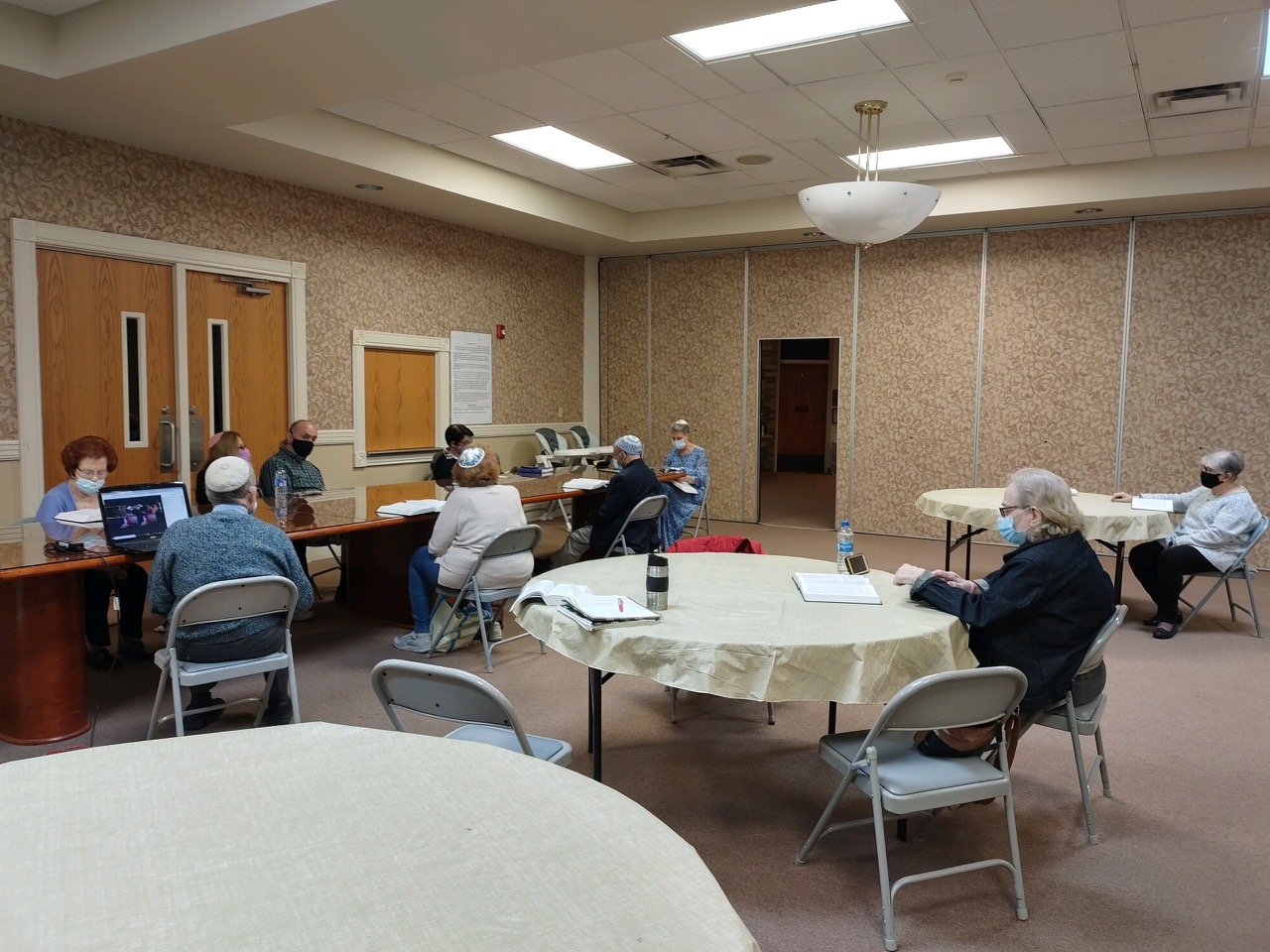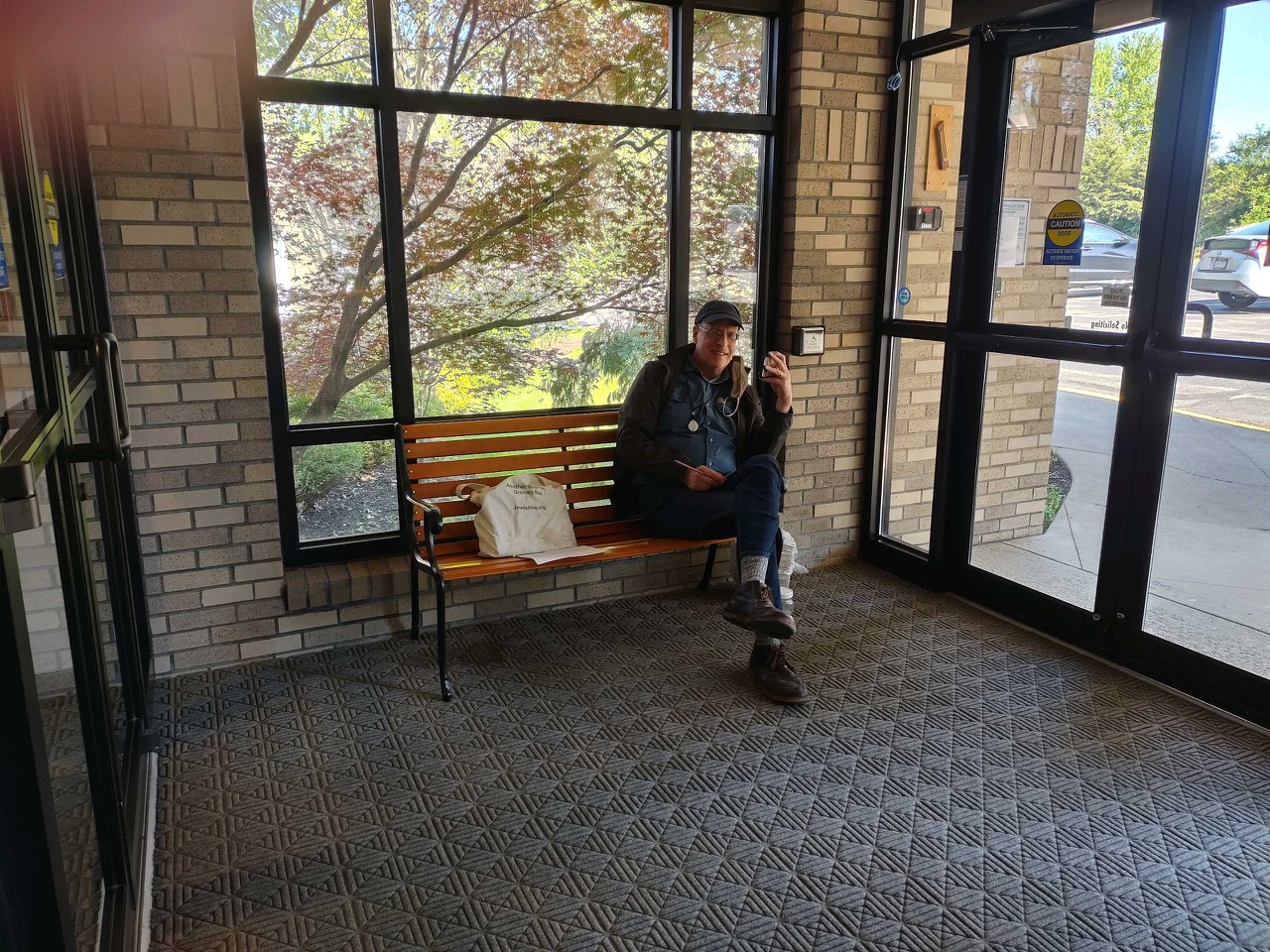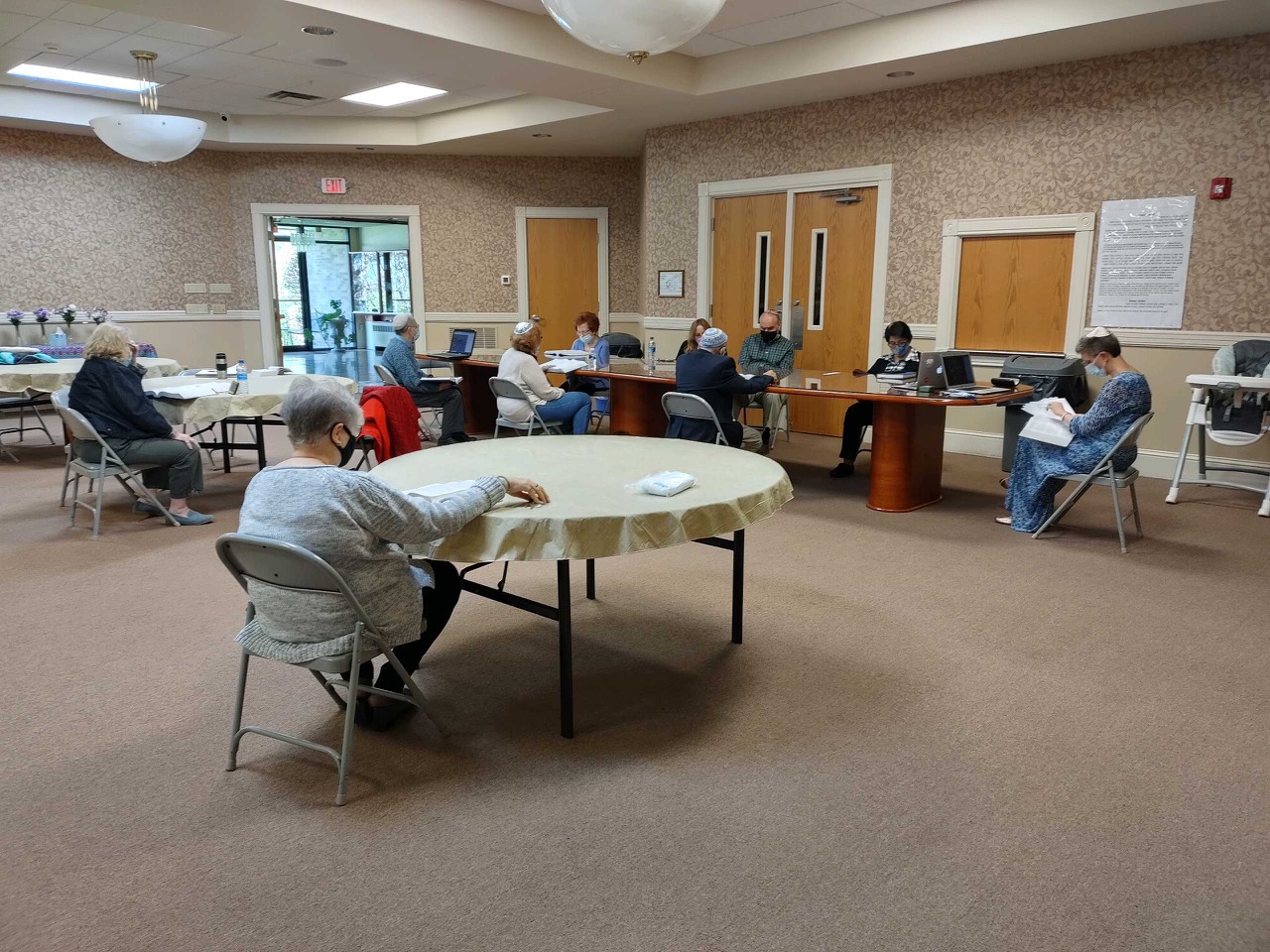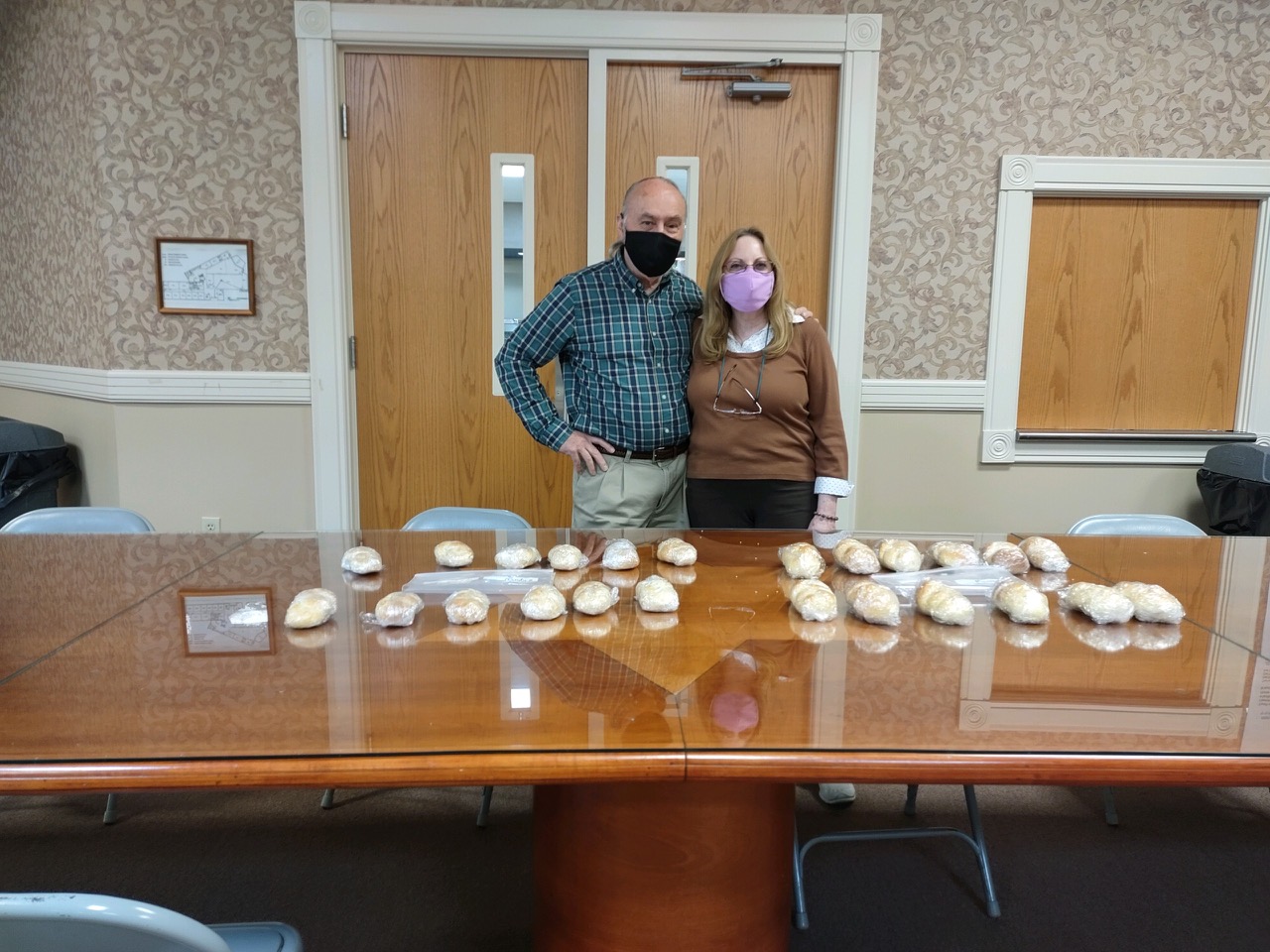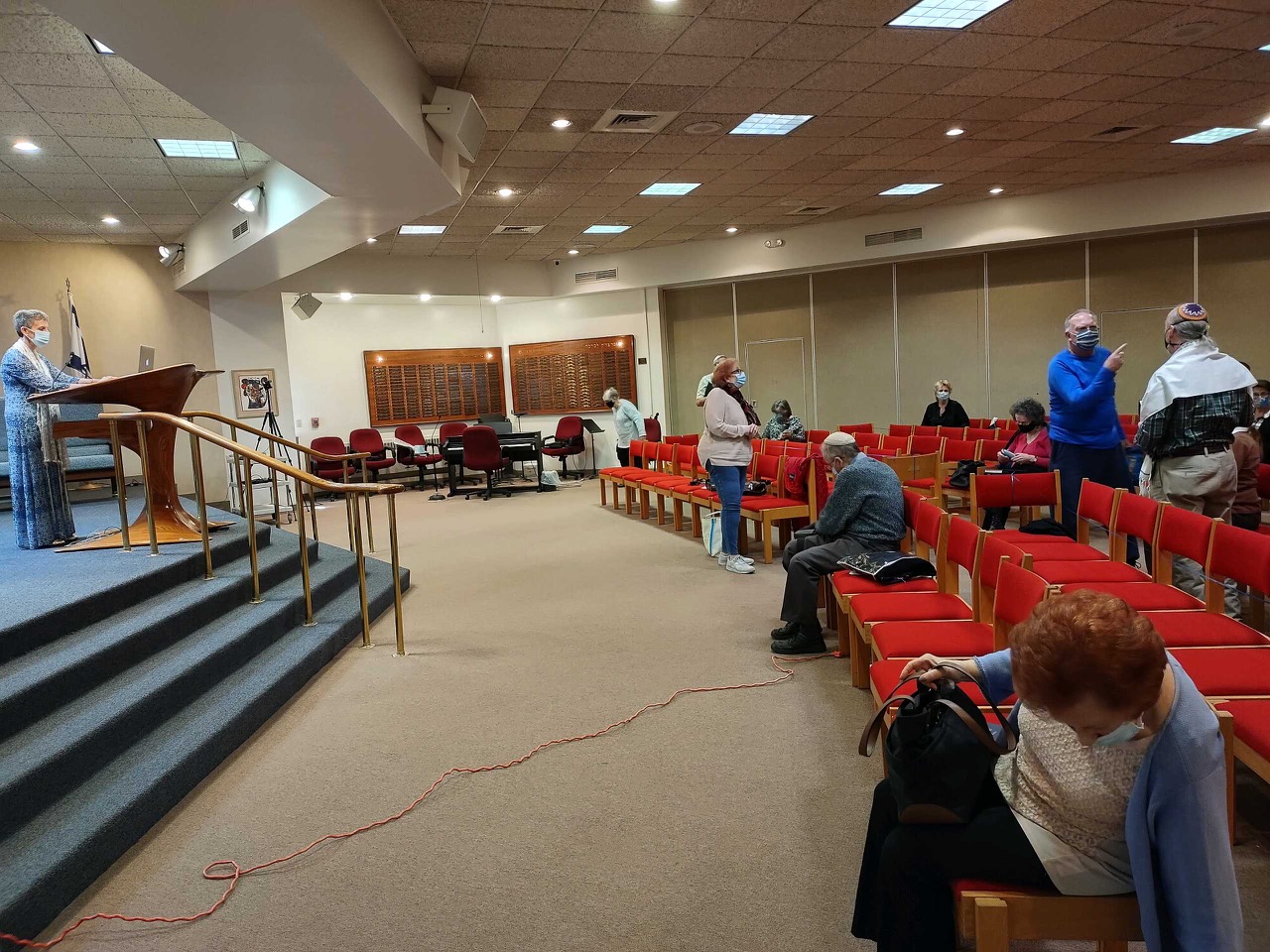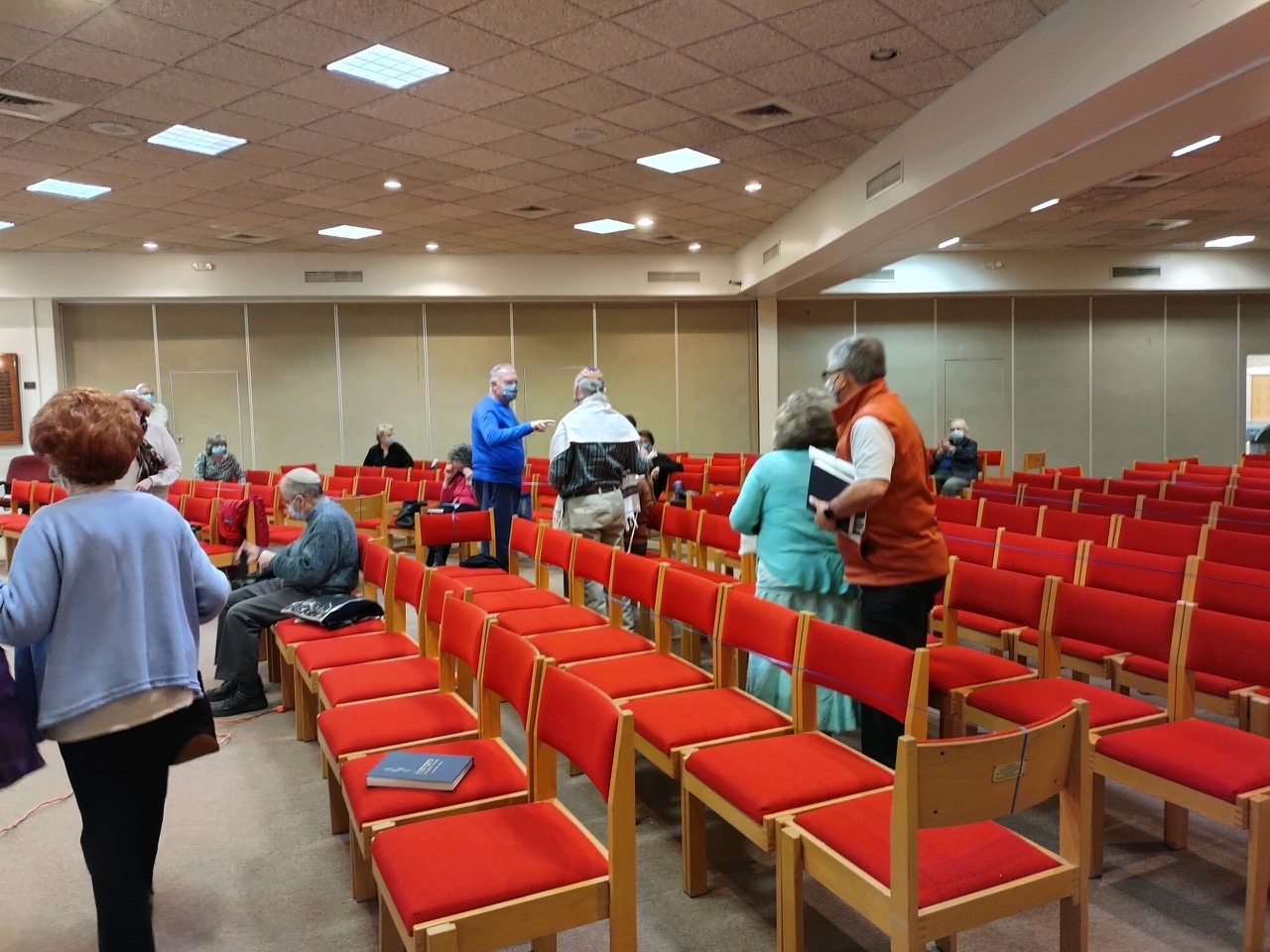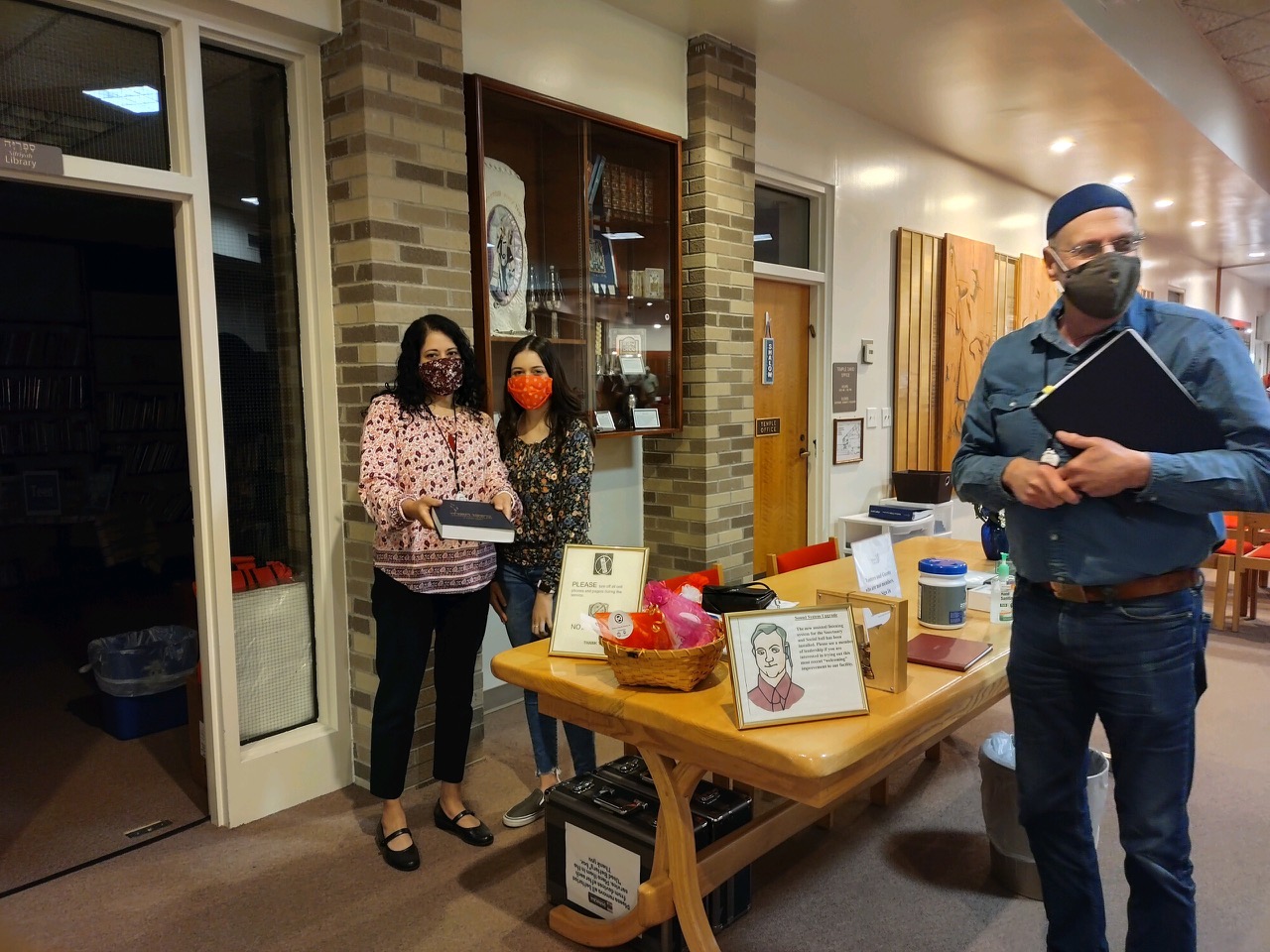
Please enjoy this archive of monthly columns.
B’vrakah,
Barbara AB Symons, Rabbi
2022 September
Israel: Talking with Our Neighbors
It was a wonderful weekend. At the end of July, a long-planned pulpit exchange between Rev. Lindsay White of Cross Roads Presbyterian Church and I, came to be. Our theme was “One God Two Lenses.” She spoke during our Shabbat morning service and her parishioners joined her. After the service, our skilled bakers and cooks shared a delicious Jewish-treats themed kiddush complete with the décor of hyssop, a plant mentioned in the Bible. On Sunday morning, I spoke from their pulpit, with congregants accompanying me. They had created a lovely fellowship time and participants enjoyed one another’s company.
But a few weeks before, The Presbyterian Church (USA), which meets every two years, similar to our Biennial, voted to not use the term “anti-Semitism” but “anti-Jewish,” and to label Israel an apartheid state. See https://tinyurl.com/3dwmxkj3 for more information.
It was a difficult time for me in terms of how to proceed. Temple David’s relations with Cross Roads have been strong for decades and Pastor Lindsay and I have developed a strong, respectful relationship which included previous conversations about Israel. I called her to express my concern about the vote and she expressed her concern about the vote as well. We agreed to address it, each speaking from one another’s pulpit and using the same words in both settings. Prior to the weekend, I shared with her the Central Conference of American Rabbis’ statement from https://tinyurl.com/2kyhjxd6. (If you would like me to print one for you and mail it, please be in touch.) She shared with me her thoughts as well.
This is what I said:
I love America but I don’t feel that every time I speak of her, I must begin with a caveat by saying, “I know she’s not perfect” or “I know there are issues…” Yet somehow when we speak of Israel, we feel the need to say those phrases. Do we say them whenever we speak about China and North Korea given their records or any other country for that matter? And sometimes, we are not allowed to support Israel at all, such as college students who are pro-Israel not being allowed to participate in other school associations.
I am not a scholar–neither about antisemitism nor about Israel, but as a rabbi, a Jew and a Zionist, here are my general thoughts in the shadow of the Presbyterian Church’s statement.
Criticizing Israel an inordinate number of times becomes antisemitic, which is defined by the International Human Rights Advocates as:
“Antisemitism is a certain perception of Jews, which may be expressed as hatred toward Jews. Rhetorical and physical manifestations of antisemitism are directed toward Jewish or non-Jewish individuals and/or their property, toward Jewish community institutions and religious facilities.”
This definition has been adopted by thirty-five countries, plus the United Nations and the European Union.
Therefore, it is hard to hear that the Presbyterian church says that it no longer uses the phrase “antisemitism.” It is a challenge, to say the least, of ownership, an ownership we wish we didn’t have but which comes from two-thousand years of being on the receiving end which often is a death sentence.
If we can’t have common language, how can we work toward common solutions?
Natan Sharansky who was imprisoned for nine years in Russia, half in solitary confinement, simply because he wanted to go to Israel and live as a Jew, finally got to Israel in 1986. I was on the tarmac at Ben Gurion Airport when he landed!
In 2004, he created the: “3D test to help us distinguish legitimate criticism of Israel from anti-Semitism. The first “D” is the test of demonization. When the Jewish state is being demonized; when Israel’s actions are blown out of all sensible proportion; when comparisons are made between Israelis and Nazis and between Palestinian refugee camps and Auschwitz—this is anti-Semitism, not legitimate criticism of Israel.”
To be clear: The Nazis had a plan for “the final solution to the Jewish question” that involved killing squads near home and exporting Jews of all ages across country lines for slave labor and execution. That is not happening in Israel. The comparison is false.
“The second “D” is the test of double standards. When criticism of Israel is applied selectively; when Israel is singled out by the United Nations for human rights abuses while the behavior of known and major abusers, such as China, Iran, Cuba, and Syria, is ignored; when Israel’s Magen David Adom, alone among the world’s ambulance services, is denied admission to the International Red Cross—this is anti-Semitism.”
I will note: The United Nations passed fourteen resolutions against Israel in 2021-2022 compared to five for all other nations combined.
“The third “D” is the test of delegitimization: when Israel’s fundamental right to exist is denied—alone among all peoples in the world—this too is anti-Semitism.”
(Sharansky’s statement is available here” https://tinyurl.com/2p877tfy)
Hamas and Iran publicly call for the elimination of the State of Israel. And if Israel, the single Jewish State in the world, were not to exist, let’s cut to the chase: just where would the Jews go…?
Books published with the world’s money through the United Nations Relief and Works Agency for Palestine Refugees, the only UN committee of its kind, includes promoting hate and violence against Israelis.
Let us not call names like “apartheid” which is hard to swallow given the ten Arab Israelis, citizens of Israel, who are members of the 120-seat Knesset (government).
This is emotional and complicated but let us use our communication skills, our connection to the Holy Land, our religious passion for justice, our local partnership, to work toward a two-state solution in which Palestinians and Israelis can live in peace.
I could have chosen to disengage and cancel the pulpit exchange but realized that was not the way forward. We must engage in dialogue and share our perspective especially when we disagree. It that much easier, of course, given the trusting relationship between Temple David and Cross Roads.
2022 August
An E-Mail from a Monroeville Resident on June 27, 2022
Dear Rabbi Symons,
I would like to report an offensive image I discovered just off of the Westmoreland Heritage Trail, that may need some attention. I have often heard that if you see something you should say something.
I really don’t know where to begin with this issue. But maybe you have some experience and could advise me if anything can be done, or if you have a suggestion where I should turn. Perhaps, ADL can assist.
I was fishing on Turtle Creek between mile marker 20-20 1/4 on the Westmoreland Heritage Trail on Saturday when I observed a very large swastika permanently embedded and molded in concrete into a large rock on the banks of the creek. An image is attached. This is a new development only appearing in just the past few days. This is jarring. I find this image horrific and offensive especially in the peaceful, and natural setting of Turtle Creek.
Unfortunately, the image may be on private property, so perhaps nothing can be done. I also suspect that some kids probably made this image, and the property owner is totally unaware, but I do not think it should be ignored. It is also right on the border between Allegheny and Westmoreland Counties so I don’t know what authorities may have jurisdiction.
If you think a group could be organized to eradicate this offensive image, I would be willing to help.
Feel free to call me if you have any additional questions. You may contact me at (Number Deleted).
Regards,
(Name Deleted)
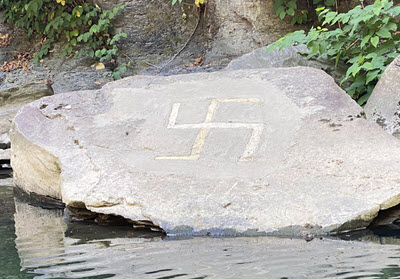
I immediately contacted Shawn Brokos, Director of Community Security at the Pittsburgh Jewish Federation. She responded immediately and reached out to the Anti-Defamation League representative who I had recently come to know based on shared preliminary work with Gateway High School on teacher training and more. Shawn and I also each reached out to Chief of Police Doug Cole who was in touch with Municipal Engineering and Planning Director Paul Hugus in order to figure out jurisdiction.
The good news is that miraculously, just two days later, on June 29, the image was removed however they are still looking into it.
These are the lessons I learned:
We have good neighbors all around us.
We have a responsive team from the Jewish and public community that works together.
Any form of hate is intolerable.
If you see something, say something.
One voice can make a difference and multiple voices can bring change.
2022 July
Frame of Mind
How many activities, relationships or jobs have you held for three-quarters of your life? Consider this: our recent Confirmands who are 15 or 16 years old, have engaged in Jewish education through JESP and the Weiger School for on average 11-12 years.
Standing in the Weiger School lobby as I addressed Andrew Bright, Gabby Keough, Malka Rubin, and Sam Sloan for the final time before entering the sanctuary, I pointed to the empty picture frame where their photos would soon hang on our Wall of Fame. I spoke of the pride we have in them and the importance to Temple that they fulfilled their pledge to Jewish learning. I shared the hope they will pursue Jewish learning and experiences and I pointed out that even over the course of the rest of their lives, there will be few things that they will do for as long as they engaged in Jewish learning (so far). Job turnovers, relationship shifts, activities and interest changes will mean that relatively few things will last for 12 years. Of course, the measure is not only the length of time that they and their families invested in religious school, but how they embody Jewish values and enact Jewish rituals. It is how they wrestle with God and how they take their places in Am Yisrael. It is what Israel means to them and how called they feel to repair the world. It is how to live a Jewish life beyond the classroom walls.
Their photo will soon take its place on the wall and for years to come, while still living at home and when they move on, when they are at Temple they will gravitate to that photo and remember their classmates, their teachers, special activities and what it means to be, in the words of our Mission Statement, a “proud and practicing Jew.”
As we pause to look at those photos, let us recognize the combined thousands of years of learning they represent. Let us continue to build a congregation that deeply values learning for all ages. Let us see in those frames not an ending but a beginning.
2022 June
Rabbi in Aisle 9, Imam in Aisle 11?

Coming out of Egypt, Exodus 19:4 says: “You have seen what I did to the Egyptians, how I bore you on eagles’ wings and brought you to Me.” God’s redemption metaphor is one thing, the actual aisles of Giant Eagle are another, aviary connection noted.
Before Passover, the local Chabad rabbi was in Giant Eagle greeting people. In past years, after some advocacy, we too have “staffed” the Jewish outreach table–or better yet, the Kosher for Passover display. He invited (at least) one of our congregants to coffee and chatted with others. Let us consider the message of clergy in the aisles–the grocery store type, not the sanctuary type.
It is good for all of us that there was a greater selection of Passover foods this year and I imagine it was due to his and Chabad’s efforts. But what do we think about religious figures in the grocery store proselytizing –if not for non-Jews to convert, since Jews do not proselytize–but for Jews to connect into our own tradition? Would you feel comfortable walking by an imam in the produce department near the dates during Ramadan– since Muslims break each day’s fast with a date? What about priests and ministers near the fish department during the weeks of Lent?
Allow a diversion. I was recently listening to a podcast by 99% Invisible entitled “It’s a Small Aisle After All: The evolution of the ‘international’ section of the grocery store and how some products stay there forever and some break free.” In their words, “It’s where you’ll find ramen next to coconut milk next to plantain chips next to harissa.” One example they talk about is olive oil. Before Italian food was beloved by Americans, which was before Italians had settled into American society and begun to do well for themselves, olive oil was in the international aisle. When Italians became more white–in the words of this episode–their foods were more accepted and olive oil migrated from the international aisle to the general–or could we say “American”–aisle. Do you think Kedem grape juice will migrate into the juice aisle any time soon? Or will sweet and sour sauce be welcomed by the other condiments?
The challenge is this: if America is a melting pot or salad or whatever metaphor suits you, is the message that “ethnic” foods are relegated to a single aisle a problematic message? On the one hand, shopping may be easier and on the other hand, those ethnic foods will never gain the status or purchasing power of foods that dwell in the regular items–the bread, cereal, condiments, and canned vegetable aisles.
Now let’s bring the themes together: America is a melting pot where all ethnicities and religions are welcome and we believe that diversity is our strength. So if the supermarket had a first amendment, it would say: keep religious figures out (religion shall not be imposed) and advocate that foods and the ethnicities they represent be seen as equal and accessible (all are free to practice their religion/ethnicity). Let eagle’s wings and Giant Eagles stand for the values of both freedom and ingathering.
2022 May
What Story Time Can Teach Us

I am proud of my good reviews.
They were from Story Time at the Monroeville Public Library when I was the guest storyteller about Passover in early April. My reviews were from the kids, parents, and from a librarian who was walking by and later commented on how engaged the kids were. She attributed it to me telling the Passover story in an animated way. I responded, “There was a good story, show and tell, frog stickers, frog jumping, singing, counting to ten in Hebrew, English and Arabic (thanks to a librarian) and snacks (macaroons). What could be bad?” It all lasted about 25 minutes.
Isn’t that what Judaism can be? Telling stories – sacred stories and personal stories – with animation and wonder, seeking to dig deeper and better connect. As we see ritual items in our break fronts, let us polish them not only literally but by sharing the memories of how they were acquired and using them often. Let us bring in joy through song and sometimes silliness. Always there must be delicious Jewish foods – both those that are heirloom recipes and those that bring to our tables the diversity of Judaism. I will admit to exaggerating in one area. I have never enjoyed macaroons with the single exception of the one that was freshly baked, half-dipped in chocolate that I ate in Jerusalem when I was last there over Passover. But I digress.
I tried to engage the adults with tidbits of learning and connection here and there. I stressed to the parents and care givers present at Story Time how important and wonderful it is to learn about one another’s faiths and to celebrate our similarities and respect our differences. It was a wonderful morning balanced by the discussion at the library the next night of Art Spiegelman’s Maus because these are the people who want to learn, to discuss, to be exposed.
By the way, at the end the little girl with the blond pigtails told me she liked my hair. I told her I liked her hair too.
2022 April
Begging the Question
The Seder’s Four Questions are too easy. We know the answers. This night is different because we are free to dip vegetables and recline comfortably at the meal, luxuries our enslaved ancestors didn’t have. It is different because we are tasting the bitterness and deprivations of slavery through bitter herbs and matzah. We know the answers, so why ask the questions?
Because the four questions are warm-ups, appetizers if you will, with the delicious added flavor of hearing our youngest ones chant them. The four questions start the questions rolling with some easy ones after which we enter the Maggid (from the same word as Haggadah) section which begins our story. Having just administered the Fundamentals of Judaism exam, I am well aware of the varying levels of questions asked. Some are straight facts, others require connecting the dots and still others require a higher level of thinking.
The seder can answer all those types of questions and launch great discussions just as its inspiration the Roman symposium did but only if we let it. Let us immerse ourselves in the story and take ownership of it so that the most important words are “we” and “our” and our past story inspires us to look critically at our world and plan hopefully for the future.
Here are some easy ways to move forward, whether you are in person or on Zoom: choose a number and say that guests will only get to eat the matzah ball soup (or your “carrot”) if that number of questions are asked and answered. Or: put something unusual on the table like a copy of the manifest listing the first person in your family to come to America or a bar of soap from an Israeli hotel or a can of soup or your polling place and don’t say anything until someone asks a question about it. Perhaps the conversations would take this turn: what were the push/pull factors for your family to come to America? Our ancestors left Egypt headed for the Promised Land; how do you experience that promise today? “Let all who are hungry come and eat”–the soup on the table is an invitation to learn about local needs. Discuss what freedom means in a democracy from voting and beyond. Be creative! Then tell me!
I wish you a Seder filled with questions and discussions and an entire week of Passover overflowing with hope and promise and the celebration of freedom.
2022 March
Not for Sale
People call for rabbinic services. Maybe they know the rabbi through a family member. Perhaps she officiated at a friend’s funeral. Maybe he taught a class and seemed approachable. Sometimes it is geographical. And often it is painful–on both ends.
They call with a specific request: will you officiate…? Can I meet with you…? Could you help me connect with an organization which can…? They are so often in pain, in mourning, not knowing where else to turn based on a personal situation. The non-members offer to pay for officiation which is ironic since the most often cited barrier to membership is monetary, despite our Commitment of Conscience dues program. For some reason, a one-time payment seems more palatable than an ongoing commitment even when finances are not an issue.
I try to say “yes” whenever I can, but Temple David and its rabbi are not for sale. I or my colleagues can officiate but, in my mind, it is about relationship, not fee-for-service. Sadness or struggle should not be limited to “a time for mourning.” As Ecclesiastes says: it is a “time for mourning and a time for dancing.” It is the continuum of life. So, when they call, I invite them into membership–it happened three times in the first two weeks of January–so that I–and even more importantly, you–can be with them not only in times of sorrow but also in times of joy.
If you know of a Jew who is lonely or struggling or aching to connect to Yiddishkeit or wanting to be embraced by a community, please invite them into the warmth of Temple David.
2022 February
90 Minutes at Temple David Will Change Your Week
Those who attend our Shabbat morning minyan know what 90 minutes can do. What we experience during a service that lasts approximately an hour and a half stays with us through the day and into the week and then we look forward to the next Shabbat morning. And all this even while Kiddush is on hold!
It is an atmosphere of interaction. We welcome one another and know to whom to say “Shabbat Shalom” and to whom to say “Gut Shabbos.” When praying for our teachers’ welfare in a special Chatzi Kaddish, I ask for someone to share about a special teacher, mentor, or coach in their life and we hear a story. Often, someone raises a hand to ask a question about a prayer or movement (also see this issue’s Ask the Rabbi).
It is an opportunity to hear our sacred texts. While usually I read and translate Torah, we are lucky enough to have a small but growing number of Torah readers. We started the year well when Mindy Norman read Torah on January 1 and only two weeks later, when Carol Gottlieb chanted the Song at the Sea.
It is an opportunity to deepen one’s spirituality. I often invite a participant to set the mood for Mi Chamochah or V’shamru–joyful? Plaintive? Calm? Then ask one of our choir members including Randy and Marsha Boswell or Carol Congedo to lead us.
It is an opportunity to grow as a service leader. A great example is Jeff Baldel who hadn’t chanted the haftarah blessings since his bar mitzvah until a few years ago and now regularly leads them as well as Chatzi Kaddish as well as the entire service. Another is the Casher-Dorra family who led worship on December 31.
It is an opportunity to get to know and value fellow congregants whether they are regulars or come on occasion. It is such a welcoming group that our regular Torah lifters Alan Sloan and Stan Beck are excited to share that honor with others, as they did on January 8 when Phil Raithel lifted the large Torah and Joseph dressed it. Kay Liss checks on regulars if they weren’t present to make sure everything is okay.
It is an opportunity to laugh a little. I don’t know when it began, but Dorothy Safchick, who comes to Shabbat morning worship “religiously,” began to remember some of the page numbers. I still can’t remember most of them! We recently honored Dorothy on the occasion of her 90th birthday and gave her her regular Fat Boy ice cream sandwiches to take home. On January 8, we formalized her role at services by presenting her with her own badge.
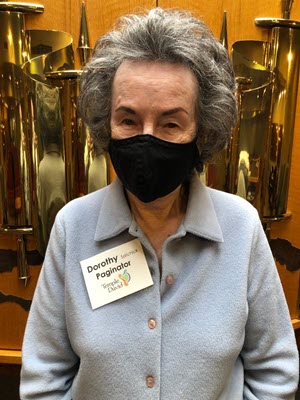
Even without a Kiddush, we leave from Shabbat morning services having prayed, learned, shared, laughed, and connected. Want to spend a meaningful 90 minutes at Temple? We have a seat for you!
2022 January
This Is The Time
There are certain legacies that we prioritize passing on to the next generations. What are yours? Some are focused on family-togetherness such as seasonal or annual get-togethers which many of us recently enjoyed over Thanksgiving. We were thrilled to return to our Grandma-to-Bubbe New York road trip with all the kids. Some legacies are skill-based such as swimming or playing an instrument. Some are focused on entertainment such as those movies, books and games that we insist that our children and grandchildren watch, read and play respectively. Some are rituals and traditions such as how we light the Shabbat candles and say Kiddush and make challah. Some are values-based such as caring for family, hospitality, generosity.
I believe that many people do not think about these consciously but believe that the skills and interests and values will magically appear. We assume: if we host family Seders then our children and grandchildren will do the same. But how could they if we haven’t taught them not only how to make seven-layered-chocolate-matzah cake as has my mother-in-law, but also why the Seder is an important reenactment of our values? Why would we expect them to be hospitable if we speak ill of relatives and friends or do not go out of our way to make visitors feel at ease? Just as valuing music takes exposure so does the art of conversation and the importance of tzedakah and the effort to be together with family.
It is not only the time to focus on actively passing our legacies on because the “other” New Year is approaching. It is not only the time because Covid has put so many things on hold and made others feel tenuous so that we are forced to prioritize what is important. It is the time because there is a scientifically measured increase in significant stress and mental illness in the younger generations and they need our loving guidance and structure. It is a fact that there is an increase in drug overdose and suicide. It is a fact that the social, educational, and health impacts of the past twenty months are exposing the gaping holes in our infrastructure. It is a fact that the ever-changing political and health landscape is why our children–and we ourselves–are having more difficulty making even simple decisions. Article after article, news report after news report, show all the above.
So let us be intentional. Whether as formal as writing an Ethical Will that becomes your mission statement moving forward, or a plan to model how to live your values and invite your children and grandchildren to be by your side, this is the time.
2021 December
Smicha: Laying on of Hands
My rabbinic studies took place at Hebrew Union College–Jewish Institute of Religion from 1989-1994, first in Jerusalem and then in New York City. It turns out that the institution was not living up to its Jewish values.
I did not study with any of the professors mentioned in the recent horrifying report about sexual misconduct, though it was an atmosphere largely of what is called the Old Boys Club. Remember that the first female rabbi was ordained in 1972 and therefore there were not only few female rabbis by the time I was in the seminary but there were fewer female rabbis who were also PhDs. We had a few adjunct professors who were women, but they did not have the status of the male full professors. I did go out of my way to work with one of them on my rabbinic thesis, Dr. Sharon Keller–who came to Temple a few years ago and taught–so I spent a higher ratio of time in the presence of a female scholar than many of my counterparts. That being said, the systemic preferences for men were unacceptable and yet at times it was hard to recognize while in the midst of it.
When I entered HUC, openly gay students were denied entrance though by the time I was ordained, they were admitted. That being said, some of our classmates were closeted and when the rules changed, they could come out. One of our professors, as mentioned in the report, who did not think people who were gay should be ordained, told us that we could come to him individually to have him sign our t’udat smicha–the ordination document–because he then would assume that we are not gay. Though an important figure not only at HUC but also in our movement, I chose not to have his name on my t’udat smicha. His name was not more important than my values.
Until the revealing article came out, I did not realize that Ron’s and my t’udot smicha were different. Indeed, Ron’s says moreinu harav (our teacher the rabbi) while mine says rav u’morah (rabbi and teacher). Frankly, I don’t understand why the differentiation was made but clearly it was made with a hierarchy in mind; male rabbis had more status. Sadly, I will look at my t’udat smicha differently from now on, lesser, yet I will not advocate for a new one as the signatures were those of my teachers and are irreplaceable. Ironically, now the names are more important than my values.
What do we do with such a stain on the single American institution that ordains Reform Rabbis? First, I praise HUC for a seemingly thorough process naming steps forward including means to report abuses that do not boomerang on the student’s academic or professional future. As a movement and as individuals, we cannot move forward unless we confront the past and present. There is institutional repentance to be undertaken and perhaps in time the students affected can find forgiveness.
2021 November
What’s In A Name?
This month is the month of Cheshvan labeled Marcheshvan (Bitter Cheshvan), because there are no Jewish holidays other than Shabbat. On the secular calendar, we have multiple holidays (if you consider Halloween secular) and find ourselves between Columbus Day and Thanksgiving…or is it between Indigenous People’s Day and The National Day of Mourning…?
For some people, hearing alternative or additional names for Columbus Day and Thanksgiving prompt a visceral negative response. “It’s ridiculous,” they say. I would like to gently challenge that based on videos I have been watching in preparation for one aspect of the Monroeville Interfaith Ministerium’s Thanksgiving observance this year. To take a brief detour, MIM’s observance includes a Gathering and volunteering together at the Greater Pittsburgh Food Bank. Plus, we are working toward serving/delivering meals to those people in need of food and/or fellowship and a discussion co-sponsored by the Monroeville Public Library about the myth of Thanksgiving. See page 2 for more details.
I have learned so much from reading and listening to lectures and it has opened my eyes. For example, using the phrase “Columbus discovered America” is something that I can no longer say or even hear without speaking up. When Columbus came to America, there were millions of indigenous people here. So how can one discover a land if people are already present–and not only present but have tribal societies, a connection to the land, and advanced farming techniques?
If we think of the first Thanksgiving in 1621, we are stymied again in that the English and Native Americans had eaten other meals together and neither the hosts nor guests marked that one in 1621 with any significance as they did with other events of import. Further, it was not called Thanksgiving–other than with a small “t” for being thankful that they had a good crop. (Don’t forget that their observance was based on Sukkot, also a harvest festival.) In fact, per www.nationalgeographic.com, it wasn’t until 1863, when President Abraham Lincoln declared two national Thanksgivings; one in August to commemorate the Battle of Gettysburg during the Civil War, and the other in November to give thanks for “general blessings.”
When we tell the myth of Columbus Day or Thanksgiving, we are complicit in making Native Americans invisible which brings continuous harm through lack of respect, equity, and resources. Let us celebrate our history and heritage in its fullness even if that is not always pleasant. Of course, we should be thankful for the blessings of the harvest and for our family and friends and for this magnificent country. Yet if we are not true to its origins, we give permission for a people to erase another and we know from our own Jewish history what that can lead to.
I wish you a meaningful, delicious, and truly American Thanksgiving in which we celebrate as one people under God, indivisible, with liberty and justice for all.
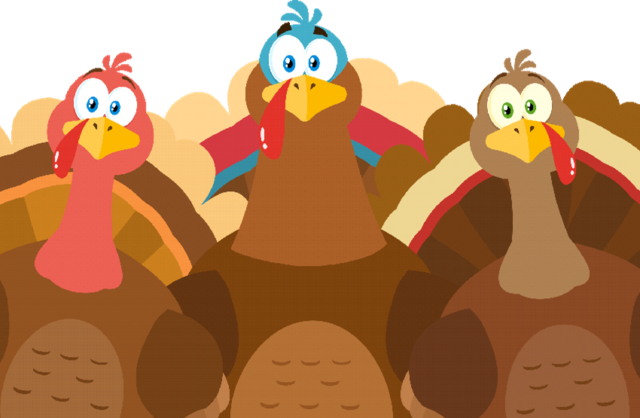
2021 October
Rabbi Emeritus Jason Z. Edelstein, z’’l
January 31, 1930—September 4, 2021
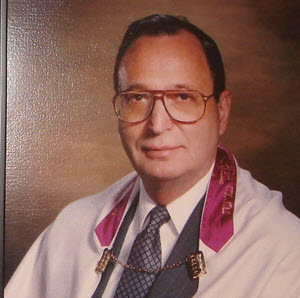 Jason Zelig Edelstein, z’’l, was a blessed man: he was Eva (z’’l)’s husband for 67 years and the father of Philip (Debbie), Sharon (Bradley), and Joey (Lori), and Zayde to Rebecca, Max, Jared, Tori, and Jordan. As their children said, they were both incredible independently and incredible together.
Jason Zelig Edelstein, z’’l, was a blessed man: he was Eva (z’’l)’s husband for 67 years and the father of Philip (Debbie), Sharon (Bradley), and Joey (Lori), and Zayde to Rebecca, Max, Jared, Tori, and Jordan. As their children said, they were both incredible independently and incredible together.
Jason Zelig Edelstein was an accomplished man: after college, he earned a Master’s in Clinical Psychology, Lieutenant and Chaplain in the US Naval Reserve, Rabbinic Ordination from Hebrew Union College, a Ph.D. He was the Rabbi of Temple David for 35 years, a lecturer at St. Vincent College and Seminary for 51 years, a Chaplain at the Veterans Administration, and for over 20 years, the CCAR’s Crisis Hotline Coordinator.
Rabbi Edelstein passed away on Shabbat Nitzavim and was buried on Parashat Vayeilech. Often these two Torah portions, which fall near the High Holy Days, are combined. This year, though they were not, they came together in reflecting Rabbi Edelstein.
In Nitzavim, we hear words and concepts such as: standing together, covenant, accessibility, the command to choose life. In Vayeilech, Moses instructs his successor Joshua, “Be strong and resolute.” All of these words and concepts describe the way in which Rabbi Edelstein lived his life.
Rabbi Edelstein was a deeply religious man who lived a life of integrity. He was strong and resolute. He believed that Reform Jews could have standards and make sacrifices. He was an erudite teacher and mentor of all ages who both pushed and nurtured people to be their best. That is why nine of his students became rabbis; his students became his colleagues. He was also deeply caring and was known as a great listener; he was a man of few but meaningful words.
As we move into this New Year, may Rabbi Edelstein’s words guide us:
“the ultimate meaning of life is not something that we personally construct, but rather it is something we must discover. And if we seek divine help in this endeavor, we will find messages that are signs that point us in the direction to fulfill our own unique destiny.”
May Rabbi Jason Zelig Edelstein’s memory be a blessing and may we all find comfort.
2021 September
The Journey Home
I write these words from a hotel room during our annual New York State tour. In a way, we are following the signs on the New York State Thruway which advertise Attractions, History, Eat & Drink, Recreation. While we engage with all of those–especially eating at our favorite childhood restaurants, we would need to add the special attraction of Family and Friends and the odd-sounding activity of Visiting Cemeteries.
Each year during the month of Elul, the month immediately preceding the High Holy Days, we begin this 1400 mile journey. While we take vacation days and enjoy our favorites, as I mentioned, (Mother Kelly’s in Long Island, The Whistling Kettle in Schenectady) and we see 15-20 family members and friends who we consider family, and we even seek a little culture and relaxation, the impetus for the timing of this trip is going to the cemeteries.
It is there, standing before the graves of relatives, now including our own fathers, that we look back. We tell stories of what was, of what could have been. We compare our ages to theirs. We look at Hebrew names and think of their progenitors as well as dates, especially when lives were too short-lived. We speak those words engraved on the markers as we put our own stones down in remembrance, joining the stones we and others previously left. We say the Kaddish. And then we leave the cemetery noting how the town has changed, how it has stayed the same all the while expecting that in a year, we will be standing at that very same sacred place.
We embark on this journey at this time of year as a reminder of our mortality. Rather than a negative, let a reminder of our mortality be an invitation to examine how we look ahead and plan for the future. Let it be a time to reassess our priorities and reprioritize our values. If we engage in cheshbon ha-nefesh, spiritual accounting, those values will become our road signs as we refuel and continue our journey into 5782.
L’Shanah Tovah,
2021 August
Prayer vs. Prayer Book
Here is a dilemma: if you find the cadence of Un’taneh Tokef powerful but the words are at odds with your theology, what do you do?
On Rosh HaShanah it is written, and on Yom Kippur it is sealed–
How many shall pass on, how many shall come to be;
Who shall live and who shall die;
Who shall see ripe age and who shall not;
Who shall perish by fire and who by water…
The dilemma is: what if you do not believe that God will write your name in a book (even a metaphoric book) which will determine whether you survive this year? Then what do you do? Do you stick with what you know and in ways that you are comfortable with, perhaps ways that you have prayed since you were a child, or do you make a change to something new that may better reflect your theology? There is no right answer, of course.
Yet our new machzor, Mishkan HaNefesh, gives you options. Here is an alternative to Un’taneh Tokef:
We contemplate a new year, and this we know:
Some of us will live and some of us will die.
Some will die young and some very old.
Some by water and some by fire…
…Even so–
the way we act,
the way we speak,
the way we meet God’s image in ourselves and in others–
These things have great power to make our lives better.
Do those words, echoing off the traditional words, resonate more with you? Perhaps so, perhaps not, but either way, our new machzor invites us–perhaps even pushes us–into the dialogue between the right-hand and left-hand pages in order to do the work of inner reflection leading to repentance and wholeness within ourselves, with our loved ones, with God.
No machzor can do the work of repentance for us especially since the “us” includes many different theologies, sensitivities and needs. But if the machzor, the music, and the surrounding community can speak to us in a way that prompts soul searching, then the service has laid the groundwork. In other words, the rest is up to each of us.
May 5782 be a year of good health, fulfillment, and peace.
2021 July
We Are All Healers
This is what I believe: it is a combination of medical knowledge and application, an individual’s inner strength and attitude, a person’s concentric circles of support, and prayer, that brings healing. Note that I wrote “healing” and not “cure” because cures cannot always occur, but healing can, be they emotional or physical.
In other words, it takes a village and for members of Temple David, we are that village. So, imagine my sadness when a congregant came in to share that she had a life-threatening illness and very few people reached out even though her name was on the Mi Shebeirach list. This is not an article about words, it is about actions.
Here is what you can do to bring healing of body and healing of soul:
- Make soup and put it in the freezer at the temple.
- Take the service handout home and write a note or call the people listed on the Mi Shebeirach list.
- If you cannot attend services, call Beverly to find out who is on the Mi Shebeirach list.
- Ask someone who is ill how you can help–but be specific:
- “I am going to the grocery store on Tuesday, what can I pick up for you?”
- “I am making lasagna on Thursday; may I drop some off?”
- When you pray privately, include the names of people in need of healing even if you don’t know them personally.
- Pick up a few extra copies of your favorite book and have them ready to lend to someone who is homebound.
- Contact Kay Liss to ask how else you can assist. (kayl@templedavid.org)
We are a village and, as we have learned the hard way this past year, a village is not about structures, it is about relationships. May those in need of healing have a R’fuah Sh’leimah, a complete recovery of body and soul.
2021 June
The Blessing of Re-Opening
Blessed are You, Adonai our God, Ruler of the universe for giving us life, sustaining us and bringing us to this moment. This prayer, the Shehecheyanu, is said when we do something for the first time or for something we have never done before. We say it as the third blessing on the first night of Chanukah because we haven’t celebrated Chanukah in a year. A person converting to Judaism says it while still in the mikvah (ritual bath), before emerging as a Jew. On each of our trips to Israel, we said it with great emotion after ascending the Judean Hills and overlooking Jerusalem.
And we said it on May 1 at Temple David. You may be racking your brain: was May 1 a holiday? No. A life cycle? No. May 1 was the first time in 14 months that Temple David was open for in-person Torah study and worship. As people entered, they were filled with joy to see one another, with relief and with a feeling of coming home.
It has been hard to reopen–and is an ongoing process as the CDC’s and Pennsylvania’s rules develop based on the evolution of Covid. Many committees are involved in figuring this out, plus there is a Re-Opening Committee that has been meeting since Spring 2020. The Ritual Committee has been working hard as has the House Committee and the Choir to figure out not only what is safe, but what is effective in meeting our mission. There is a technology sub-group that employs such phrases and technology as “ethernet” and “interface.” Thank you to all for the work you have done and the work yet to be done to keep us safe and connected.
We are worn yet resilient, heartbroken over the ongoing loss of life and therefore deepening our celebration of life, remembering (first world) scarcity and rethinking our values, and thankful for the great and creative minds that brought the Covid vaccines to us and, with it, health and first steps toward a new normalcy. The Shehecheyanu said it all: Blessed are You, Adonai our God, Ruler of the universe for giving us life, sustaining us and bringing us to this moment.
Photos: Deb Scheib
2021 May
Next Year in Jerusalem?
There is Am Yisrael (the People Israel, meaning all Jews), Eretz Yisrael (the land of Israel) and Medinat Yisrael (the modern State of Israel). This tri-part Israel is a part of every Jew; whether we choose to engage and reap the joys and accept the challenges is up to us.
Focusing on Medinat Yisrael, let us hear what the 1999 Central Conference of American Rabbis, our Reform rabbis, statement says:
“We are committed to (Medinat Yisrael), the State of Israel, and rejoice in its accomplishments. We affirm the unique qualities of living in (Eretz Yisrael), the land of Israel, and encourage (aliyah), immigration to Israel.
We are committed to a vision of the State of Israel that promotes full civil, human, and religious rights for all its inhabitants and that strives for a lasting peace between Israel and its neighbors.
We are committed to promoting and strengthening Progressive Judaism in Israel, which will enrich the spiritual life of the Jewish state and its people.
We affirm that both Israeli and Diaspora Jewry should remain vibrant and interdependent communities. As we urge Jews who reside outside Israel to learn Hebrew as a living language and to make periodic visits to Israel in order to study and to deepen their relationship to the Land and its people, so do we affirm that Israeli Jews have much to learn from the religious life of Diaspora Jewish communities.”
In ways, 1999 feels like a very long time ago regarding Israel, especially since there have been four elections over the course of the past two years and archeological digs have found cloth from King David’s time (1000 BCE) and more Dead Sea Scrolls to name only a couple of recent finds. Israel led the way in Coronavirus vaccines for her citizens and, as always, is on the cutting edge of new technologies for example: The glaucoma treatment that only takes seconds, a spray-on skin that is better than a bandage, a new handheld device that aims to calm panic attacks fast. (See https://www.israel21c.org/topic/technology.)
As with every country, there is work to be done: advocating and supporting Israeli organizations and institutions which promote full civil, human and religious rights as well as specifically advocating for Progressive Judaism to have an equal voice in a Jewish state that has no separation of “church” and state. That conversions by Reform and Conservative Israeli rabbis are now recognized per the Israeli Supreme Court is only one step.
Have you heard the expression “Nothing about us without us?” Since Israel is the Jewish state, since it sits within Eretz Yisrael, since the majority of Am Yisrael lives within its borders, how can we debate and take pride and critique and support without being there? So, let’s go! Temple David is in the process of planning a trip in 2022. We may even go as early as March 2022 so we can celebrate Purim in Israel! Please contact me for more information and to add your voice in planning our itinerary. I would love to travel with you! Also, the next Trip Meeting is Sunday, May 16 at 10 a.m. on Zoom.
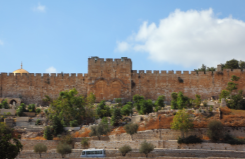
2021 April
Appreciation
In March, the Pittsburgh Jewish Federation led an initiative to express appreciation to professionals working in Jewish institutions and on April 16 Temple David will host a volunteer appreciation Shabbat.
In Hebrew, the word for “appreciation” isהַעֲרָכָה (ha’aracha) which shares its root with the Hebrew word for “value.” When we appreciate someone or something, it is because we value them/it.
How can we show our appreciation for our professionals and volunteers? It is not complicated but it is, as they say, priceless. Call them to tell them how much you value them. Write a note. Make a donation in their honor. Voice your appreciation publicly when you next see them–yes, even on Zoom. Making an effort to express appreciation is not only important for the recipient but for the giver as it is a type of moral balance sheet which highlights what one values.
While I hope that you hear my appreciation repeatedly, and in many forms, I would like to express it here. Temple David has a small professional staff and therefore it takes every one of them to do their part with dedication in order to allow the Temple to live our mission statement daily. Suddenly switching to an entirely new way of doing things that seemed short-term and then morphed into a year and counting took extra effort and creativity. Thank you to our professional staff for being my partners. Someday soon, I hope to again tell you in person how much I value you.
Temple David runs on volunteers. Whether a board member, committee member, project manager, or helper of another kind, every one of you allows us not only to enact our mission statement but to do so with energy, warmth, creativity, compassion, and Jewish values. Whenever I find myself describing Temple David, it is within one or two sentences that I mention the importance of you, our volunteers. During Covid, you quickly pivoted for the short term and then made plans for the long term. That during this time, we have stayed strong and connected is a tribute to you. Thank you for being my other partners. Someday soon, I hope to again tell you in person how much I value you.
Just like Mother’s Day or Father’s Day should not be the only days when we express our love and appreciation for our parents, may Professional and Volunteer Appreciation Days only be one of 365 days of appreciation.
2021 March
Shabbat Shalom
Have you ever wondered what happens during Shabbat morning worship? Here is the bird’s eye–well, Zoom’s eye–view:
Because of our regulars, the service never feels static. That might sound ironic, but it is true. As individuals embrace their knowledge and courage, they begin to lead some of the prayers in Hebrew, otherwise I invite them to lead in English. Before the creative version of Kaddish d’Rabbanan, the Kaddish said in honor of teachers, I ask someone to share the story of a special teacher, mentor, or coach and then we pray the prayer together. Through their stories, we get to know them.
When we get to V’shamru or Yism’chu, the songs about Shabbat, I ask one congregant how they are experiencing Shabbat: joyfully or reminiscing, quietly or traditionally, and then ask one of our singers to lead a version that reflects that feeling; the same happens for Mi Chamocha. We know what prayers are particularly meaningful to whom, we pause when someone has a question. While we miss schmoozing time around the kiddush table, we do share before, during, and after the service.
Shabbat morning is an example of our traditions giving us strength and joy even during difficult times. It is proof that relationships can flourish even via Zoom. That being said, we of course are looking forward to being in person. Whether online, or eventually in person, please step into this world of prayer, relationships, and shalom.
2021 February
Wearing Your Values on Your Sleeve
January 6 will be a date whose images stay in our minds for years to come. How many of our fellow citizens got all dressed up and had somewhere to go: to the Capitol. The dress code was one of hate and intimidation; if they were students in our schools, they would have either been sent home or told to change their clothes.
Many articles were written with accompanying photos of our fellow Americans wearing t-shirts that read: “Camp Auschwitz,” along with the message “Work brings freedom.” We saw NSC-131 which stands for Nationalist Social Club (the 131 division is from New England). We saw images of Crusader Crosses. “Intactivists” were all dressed up. They support banning all forms of circumcision and often feature anti-Jewish imagery. We saw a coiled snake above the phrase “Don’t Tread on Me,” known as the Gadsden flag, which symbolizes support for gun rights and individual liberties; clothing sported QAnon logos and even the Marvel comic anti-hero The Punisher showed up who is now associated with white nationalists and neo-Nazis. Then there was “6MWE”—that’s code for “6 million wasn’t enough.” Beyond clothing, we saw accessories: Confederate flags and a noose. It was a sea of anger, hate, intimidation, and “us” versus “them.”
This is what I believe: if you say or wear something anti-Semitic, you are an anti-Semite and you don’t get to define what an anti-Semite is; we do. If you say or wear something racist, you are a racist and you don’t get to define what a racist is; someone of color does. Need I go on?
So how do we respond to the events of January 6 and the fact that these groups wore their hate on their sleeves, chests, backs, and heads? Systemically. We must work with our partners to call out hatred, intolerance and intimidation for what it is—and our partners include the Jewish Federation, the Monroeville Interfaith Ministerium (MIM), and the Community Network (the community arm of MIM). We must work with our schools to make sure that all American children are exposed to multi-cultural curricula and even more importantly, ensure through our advocacy and our votes that teachers and school boards look like the students. We must elect council members who reflect the communities they serve.
We know that challenging situations can make us stronger. May America go from strength to strength–not the strength of violence, but the strength of inclusion.
2021 January
Jewish Antibodies
In the seventh month, on the first day of the month, you shall observe a sacred occasion: you shall not work at your occupations. You shall observe it as a day when the shofar is sounded. (Numbers 29:1, Machzor) This always confuses us; that Rosh HaShanah, the new year, is in the seventh month. Perhaps it helps a bit to know that there are a total of four Rosh HaShanahs dotted throughout the year, each focused on a different accounting. Perhaps that only confuses the matter.
As we enter this new year of 2021 with the promise of a vaccine, it could be that the other seventh month –July–will be a day for sounding the shofar, as it were. Perhaps it will be that we will finally feel a new normal that allows us to gather together mask-less and perhaps even shake a hand or offer a hug. Perhaps we can dine at our favorite crowded restaurants and go to a movie. Perhaps we can fly to a vacation.
In the meantime, we have months ahead of us to stay safe and healthy. Often we define “health” as bodily but as I have been incorporating into the Mi Shebeirach (prayer for healing) for months now, we pray not only for healing of body and soul, but for healing from mental illness, abuse and addiction.
It occurs to me that the uniqueness of the vaccines being developed, in that they recreate the genetic code of the virus so as to produce antibodies, have a lesson for us. As we wait for the vaccine, we need to develop our inner resources, for example: resiliency and patience, humility and gratitude. (For a fuller list go to: https://is.gd/mussar01) These are all middot, personal virtues, part of a Jewish practice called Mussar defined as “a Jewish spiritual practice that gives concrete instructions on how to live a meaningful and ethical life” or as Rabbi Bahya Ibn Pakudah in 11th-century Spain wrote, “the science of the inner life.” For more details, please go to: https://is.gd/mussar02
Of course, there are resources that we need that are not found within ourselves and we must allow ourselves to seek the help we need. JFunds in Pittsburgh can provide some financial assistance, AgeWell can provide guidance around the challenges of aging and/or caring for an aging parent or family member. Especially of concern are our youth whose world has been turned upside down. Temple David is participating with The Jewish Federation of Pittsburgh to identify the needs and respond to them. If you would like to know more about any of these resources please contact me.
If you are seeking other help, please see the list of services compiled by the Monroeville Public Library at https://www.monroevillelibrary.org/local-resource-guide.html. Also, the United Way can be reached by dialing 411.
May 2021 be a physically, mentally, emotionally and spiritually healthy year for us all.
2020 December
Prayer by Numbers
A very interesting conversation took place at the November Ritual Practices Committee meeting. It focused on the fact that for many weeks, I have been giving the most updated aggregate number of Covid-19 cases in America during Mi Shebeirach (the prayer for healing) and the most updated number of Covid-19 deaths in America during the Mourners Kaddish.
The first concern voiced was that it was political. Admittedly, I dismissed that fairly quickly in that I will not allow for someone else to label something I say (in any context) as political in order to silence me. If one wants to engage in a dialogue, then I am ready to listen, wrestle with the notion, and consider changing my outlook and action.
That was precisely why the conversation was so interesting. Here are some of the ideas and values brought up and my responses, so far. I write “so far” in that I welcome engaging with you in this conversation. The concern seems to be that I was citing the aggregate number of cases and could have chosen to only cite the most recent cases given that we only pray for healing for those people in need of healing and some people have healed. That is certainly valuable feedback as it speaks against praying in vain, which is against the Second Commandment (“not taking God’s name in vain.”) The challenge for me is: what of those people who have been suffering for a few weeks or those with long-term health challenges? Another issue brought forward is the challenge of mentioning only those suffering with Covid-19 and not other illnesses. Again, that is certainly valid and heartfelt. My response was that while anyone at the service can mention an individual in their prayers and even extend their prayer to all suffering from the same disease, I do try to mention other illnesses, the most recent case in point being October when I mentioned Breast Cancer Awareness Month and Domestic Abuse Awareness Month. I also mention that the healing for which we pray is healing from physical illness, mental health illness, addiction, and abuse. Further the prayer itself prays “May they be granted a r’fuah sh’leimah along with all others who are ill…”. But again, a valid point. I believe the follow-up question to be: should we not mention Covid-19 because we cannot mention every illness from which people suffer?
When I lead a prayer, be it Mi Shebeirach or Kaddish, clearly among the most emotional prayers we pray, my intent is to punctuate this communal part of our conversation with God with compassion and awareness so that we can also be present for one another. To be in the midst of a pandemic, as I said at the meeting, and not mention Covid-19 is to make ourselves irrelevant. To not mention a number but rather a broad statement such as “those suffering from Covid-19” does not remind us that they are individuals like my husband Ron’s Uncle Marty and our best friend’s mother, Lin–both of whom died from Covid-19–and the phone call I received just yesterday from a congregant whose family members are suffering now, and the one I received while writing of a congregant waiting for her test…
The most recent number of cases that I shared was: 9,581,770 and the number is exponentially rising. If Mi Shebeirach is to appeal to God and ourselves, the message is clear: May those suffering heal. And the corollary message is: take care of yourself. Be safe. Wear a mask. Social distance. Wash your hands.
The question regarding the number said at Kaddish was: would we ever stop saying that number? God willing, someday the number of new cases will be zero and perhaps then we will stop saying the number but at the moment, in the midst of a pandemic with rising numbers, I am just not ready.
I will continue to try to balance how we remember victims of Covid-19 in ways that are in alignment with our Jewish values, and to that end, I welcome your input. May those in need of healing be granted a r’fuah sh’leimah, a complete recovery.
2020 November
Prophetic Voices
Writing a book is a fascinating experience. While I am actually the editor, not the author, I have the pleasure of working with many parties. The Editorial Committee consists of approximately 15 people, many of whom I knew personally and asked to participate and a few of whom were suggested to me. They helped to shape the overall book. I work very closely with a particular editor from the CCAR Press who, besides being a scholar with a great sense of humor and very creative, is from Germany, ordained through the Abraham Geiger College, whose English is better than mine! And then there are the over 150 authors…
But first, a bit about this book. Think of your bar/bat mitzvah haftarah portion–or that of your child or grandchild or family member. Or think of a festival haftarah. What do you remember? As a reminder, the haftarah (meaning: conclusion) is the portion from the Prophets section of the Hebrew Bible that often relates to the Torah portion and sometimes relates to the time of year–leading up to Pesach or near Tisha B’Av for example. The connection to the Torah portion may be tenuous or may be strong–but often has limited relevancy, at least on the surface. For all of the hours that a bar/bat mitzvah student spends learning to chant the haftarah, it is often skipped in Reform congregations, camps, and gatherings and rarely studied even by adults because it does not speak to us.
This is where the book comes in. Called Prophetic Voices: Renewing and Reimagining Haftarah, the intention is to reinvigorate the traditional haftarah cycle through short contemporary interpretations and to offer new alternative Jewish voices to punctuate each Torah portion and holiday. In addition, prophetic voices are being offered for the American Jewish civic calendar–from July 4 to Thanksgiving to Breast Cancer Awareness Month to Pride Month and almost everything in-between. What is an alternative prophetic voice? A text from elsewhere in Prophets or Writings; a Talmudic text or story, a medieval commentary, or modern Jewish poem or speech. Every single one ends with a call to action–whether that action is caring for others, social justice, or seeking spirituality–all of which find their inspiration in the second haftarah blessing. The interpretations are written by rabbis, cantors, educators, students, scholars, and lay people all preceded by essays about the prophets, the evolution of the haftarah cycle, how Reform Judaism came to be known as “prophetic Judaism,” and prophetic Judaism in action. Included will be alternative blessings for these creative texts.
I have been in touch with hundreds of people, read and edited hundreds of essays, and learned a tremendous amount from the contributors. By summer 2021, it will be with great pride that my name will be on the front cover of a volume that has the possibility of renewing and reimagining the haftarah cycle.
2020 October
What to do about Simchat Torah?
Rosh HaShanah was a challenge so we met up for Tashlich and Shofar on the Roof. Yom Kippur was a challenge so we pre-recorded Avinu Malkeinu and had an item of remembrance next to us during Yizkor. Sukkot will be a challenge so we built a one-at-a-time sukkah at Temple and invite individuals and families to reserve a spot or build one at home.
But what to do about Simchat Torah?
Simchat Torah—literally “Rejoicing with the Torah” should include 7 hakafot with our three festively-dressed Torah scrolls, flags waving in the air, and ceremoniously concluding Deuteronomy and then beginning Genesis, topped off with caramel apples and cake for our newly-consecrated students.
As with anything, a celebration should not last one day. We should not pause to allow ourselves to be filled with thanksgiving only on the fourth Thursday of November. Mothers and fathers should not only receive loving cards filled with appreciation one day a year. Americans should not give voice to our patriotism only when the calendar directs us. We could not think of only honoring our veterans on a given day in November. So too with the Torah.
We should not take the Torahs out of the ark, parade with them, sing about them, unroll them with crowds trying to get a peek, and then lock them away in the ark. We are commanded to “la’asok b’divrei Torah”—”engage with the words of Torah” through study and real-life application. And so we shall! We will continue to offer the variety of study opportunities including a nine-month-long class on the Prophets (feel free to register even though one session has already taken place), Jewish Business Ethics, book discussions, Hebrew, and more. This is the year to say “yes” and try one out. Though the Torahs will not be celebrated with their usual pomp and circumstance—or more correctly, L’cha Adonai and Rom’mu—let us celebrate them all year through.
On the evening of October 9 and the morning of October 10, be ready, however, because we may not celebrate as usual, but celebrate we will.
2020 September
5781: Turning Unprecedented into a Positive
Think of how our language has changed. The words “unprecedented,” “pandemic,” “virus,” “shutdown,” “masks,” “Zoom,” “virtual,” let alone “systemic racism,” “Black Lives Matter” are new to our daily vocabulary. We knew what they meant previously (well, maybe not “Zoom”) but they had not taken up permanent residency in our lives. I believe that though we have been in pandemic conditions for six months, it is still a shock to our system both as individuals and as a society.
The words and the way of life they require have a parallelism to the call of the High Holy Days. The shofar’s “tekiah” calls out to wake us up, the words of the liturgy, “Avinu Malkeinu,” “Hear our voice,” “All our vows,” “For the sins we have committed” combine with the stories we tell as Abraham ascends the mountain with Isaac, Jonah finally does as told but with regret and we stand together this day. We add in wearing white, lighting yizkor candles. Ancient primal sounds combine with music, prayer and ritual, to agitate us into action.
Even in this unusual year when we will not be in our sanctuary to greet one another, see the grandeur of the Torahs dressed in white, and be warmed by the glow of the yahrzeit lights and their accompanying memories, the call of the High Holy Days is no less loud than in previous years. In fact, it might be louder. This year, with over 170,000 American lives lost and over 700,000 world-wide lives lost to COVID-19, and black lives lost to systemic racism, humanity’s fragility confronts us daily. That is precisely the message of the High Holy Days: life is fragile, live it well.
As God commanded the Israelites to create the tabernacle, God said, “Build me a sanctuary that I may dwell within you” I invite you to create a sanctuary that invites God in. Fashion your mikdash m’at, miniature sanctuary at home by thoughtfully choosing where you will be for worship, dressing as though you were coming to Temple, putting out flowers and lighting candles for both Yom Tov and Yizkor. When God is present, we can each get down to the hard but necessary work of reflecting, repenting and asking for forgiveness. It is in our power to make these High Holy Days unprecedented in a way that brings comfort, renewal and hope.
We mourn the fact that we will not be together in person even as we celebrate our age-old tradition that invites us to begin again.
L’Shanah Tovah u’Metukah–May 5781 be a Good, Sweet, Healthy New Year,
2020 August
Smaller Can Be Better
When I was a child I grew corn and, at least as I remember it, I was quite successful.
Every Shavuot and Sukkot, one of the group aliyot is for “the farmers and gardeners among us.” Every time, I am so impressed with the variety of what many of you till and tend, the skill with which you seem to do it and the delicious fruits, vegetables and herbs that you and G-d partner to produce. Each year, as you leave the bimah, I would say to myself: this is the year I will try my hand.
So this year, from seed, I tried my hand at tomatoes, snow peapods, beans, and cucumbers. So far, so good –though I won’t tell you the embarrassing parts of this adventure. I am even currently pickling some of the cucumbers. Some of you have provided terrific advice which brought me this far. Thank you.
I have nurtured the seeds, seedlings, and now plants and I’m learning about how to care for them, and I’m considering what I will plant next year. I show my mother my plants when we Skype for dinner. With education, effort and care comes connection and pride.
I invite you to think about a project on which you have embarked that fits these parameters. Perhaps you mentored a child or wrote an article or figured out how to braid that perfect challah. How did you choose it? What did you learn? How did you feel as it progressed? Did you use what you learned to teach others?
We are living in a world in which we desperately need to plant seeds and nurture them. How many times must we quote Pirke Avot: “It is not upon you to complete the work but neither may you desist from it.” How many times? Many, many times!
Choose your issue: health care disparity, Black Lives Matter, anti-Semitism in America and around the world, civic engagement around voters rights, climate change, or something else meaningful to you. Then: start small. Just a seed. We know that often when we want to change the world all at once, we get disenchanted and burned out. Plant your seed and nurture it. You could end up with one small change or a field of dreams.
2020 July
First Responders are People of Faith
Pastor Niecy Dennis of The Lord’s Church said “first responders are people of faith.” She said it when I called her to talk about how we–and I–should respond not only to the death of George Floyd but to the underlying racism that caused it. She also said, “it is just like the pandemic; we have no choice but to act.” I agree. The question is: how?
If we who know what it is to be an oppressed minority and what it is to have privilege, we must get involved and share our experience, skills and advocacy. Just look at how effectively we have assimilated into America (sometimes we might say too effectively). Yet even as we face rising anti-Semitism, and because we face rising anti-Semitism, we must get into this fight. When one group is attacked, at some point all are attacked. Having just discussed Bari Weiss’s book How to Fight Anti-Semitism, she states so clearly: Jews are at once white and nonwhite; the handmaidens of white supremacy and the handmaidens of immigrants, and people of color; in league with the oppressed and in league with the oppressor (p. 69). We are accused no matter which side we stand on–but that is only if we let the accuser define us. To self-define, it is to stand by our values and stand up for others, “Do not stand idly by while your neighbor bleeds” the Torah exhorts us.
For many of us, we may think the problem of racism is too big but that is when we turn to Pirke Avot which says “It is not for you to complete the work but neither may you desist from it.”
Racism in America predated the founding of our country but as Pastor Dennis says, “we have no choice but to act.” Call a black friend and ask how he/she is and if you don’t have a black friend, consider why. If you hesitate to get involved with Black Lives Matter (BLM) because of past statements against Israel, consider that that has been off their agenda for four years and yes, people and organizations can change. If you think that supporting BLM means you are making a statement against the police, know that as I set out to join the march in Monroeville, I first texted our Police Chief and a Sergeant with whom I work closely and said, “As I head out for the March, I want you to know, as you already do, that I support our police department and also realize the desperate need to end racism in our country.”
Take the first step to end racism in America: be it in a march, to the polls, to support a black friend, to patronize a black-owned business. Be a first responder.
2020 June
A Rabbi and a Saint
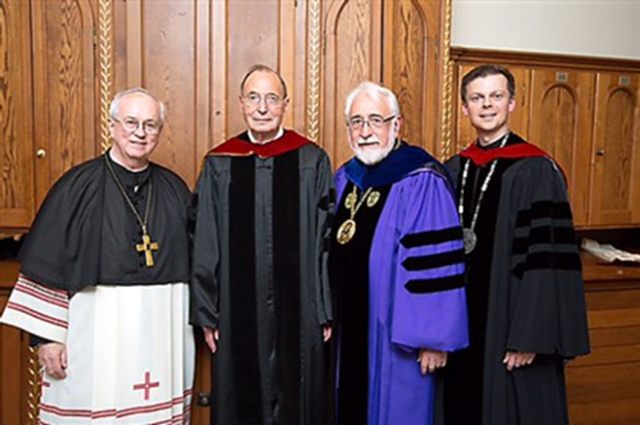
After fifty-one years, it is with a particular sense of awe and respect that we celebrate as Rabbi Jason Z. Edelstein retires from his position at Saint Vincent College.
Not knowing much about saints, I learned a bit about Saint Vincent from www.catholic-saints.info. The man who became known as Saint Vincent was born in France and became the Deacon of Saragossa in the former Kingdom of Aragon, Spain in the third century under two Roman Emperors who reigned jointly. They fiercely persecuted the early Church, making it a particularly dangerous time to be an adherent, which Saint Vincent was. He was arrested and tortured to death.
The fact that Rabbi Edelstein began teaching at this saint’s namesake, St. Vincent College in Latrobe in 1968, is a mutual tribute to St. Vincent the man and St. Vincent the college. Only three years prior, the College had held a Catholic-Jewish seminar which demonstrated that the College and Seminary held the value of interfaith dialogue, parallel to what was happening in the Roman Catholic church with Nostra Aetate. That led to courses about Judaism plus the chutzpah, as it were, to engage a rabbi to teach the men who would become priests.
Rabbi Edelstein first taught Introduction to Judaism and through the years taught The History of Jewish Thought, American Judaism, Holocaust, and Catholic and Jewish Thought, as well as Pastoral Counseling within the Seminary.
As Rabbi Edelstein said in an interview for the Pittsburgh Post-Gazette in November 2015 upon the establishment of the Rabbi Jason Z. Edelstein Chair of Catholic-Jewish Dialogue: his experience at Saint Vincent has “made me a better Jew, a better rabbi.” “To be able to know what you believe in, you have to be able to explain it to others, and to explain it to others, you have to be open to the challenge they face in trying to understand you,” he said.
Rabbi Edelstein taught multiple generations at St. Vincent and whether they took his guidance into the world of relationships, work and civic duty, or into the priesthood, his influence has spread far and wide.
Rabbi Jason Z. Edelstein, may you go from strength to strength.
2020 May
Teachers: Our Jewish Heroes
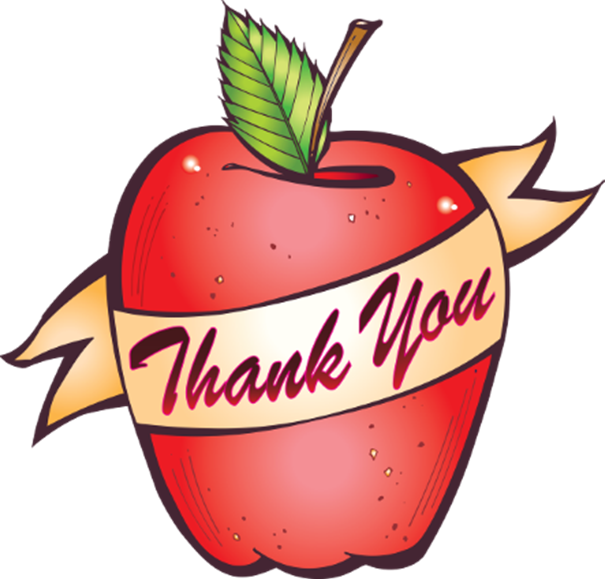
Pennsylvania schools are now online through the end of the year. As teachers learn a new way to teach and parents become teachers, it has brought me to thinking about the special teachers in my life. Who are the special teachers in your life?
The first that comes to my mind, oddly enough, is my 12th grade gym teacher. Yes, we called it “gym” back then. I feel badly that I don’t remember her name. A bit of history: throughout elementary and middle school, I was the kid who was picked last or second to last for the team–kickball, softball, you name it. But as a high school senior when we had the (in my mind, dreaded) gymnastics rotation, my teacher saw that I was willing to try and she worked with me each class to help me on the uneven bars. I did not accomplish anything worthy to the outside eye, but to me, I was deeply proud of my accomplishment and deeply appreciative of my teacher’s encouragement and attention. I can only imagine that she impacted my current exercise routine.
I think of Mrs. Schechter, my religious school Hebrew teacher, who taught us through helping us to aim ever-higher and modeled that herself as she continued her own Hebrew studies at a nearby college. When we moved away for a year while I was in 8th grade, she continued to teach me through the mail and I continued my Hebrew studies through 10th grade in order to take the New York State Regents exam. My Hebrew studies continue to this day in varying forms.
I think of Rabbi Alan Ullman, who I met while working at my first job at the JCC in Worcester, Mass., who welcomed me, and a few of his other students, to his home every Saturday afternoon so we could wait for three stars to appear and celebrate Havdalah together. He opened up texts for me–such as Honey From the Rock by Rabbi Lawrence Kushner–in a way I had never studied before and then he opened the door wider and wider until I stepped through and applied to Hebrew Union College. We are now colleagues.
Of course, I could go on and on, as could you. And we should. Let us show our appreciation to our own teachers–perhaps a note or email or a story if they are no longer with us. And as parents become teachers, let us show appreciation to our children’s teachers. Look at what they do each day.
Let us also reflect that, in recent weeks, every one of us has become a teacher in some way. I think of my sister and brother in law who ordered a computer, programmed it, sent it to my mother and spent time teaching her how to Skype so she now eats dinners with both families rather than being alone. I think of our congregants on our Zoom services and gatherings who help one another start the video or connect the audio. I think of Norm who has figured out how to lead choir rehearsals online.
Judaism has always venerated learning. The leader of the Jewish community is not a “priest” or “minister” but a “rabbi” (teacher). The Talmud directs that one should not live in a town without a teacher. The “catch” for a young woman was to marry the rabbi’s son. (Proof: think of “Fiddler on the Roof.”) During every service and after every traditional study session, we pray for the well-being of our teachers.
Rabbi Elazar ben Shammua said (Pirke Avot 4.12): “Let the honor of your student be as dear to you as your own, and the honor of your colleague as the reverence for your teacher, and the reverence for your teacher as the reverence of Heaven (meaning God).” Let us bring our values into action as we continue to teach others and show appreciation for those who teach us.
2020 April
Redefining Community
It was hard to be away. As I said in my December letter, you are the community with whom I learn, pray and change the world. I missed doing all those things and simply chatting at oneg or Lunch with the Rabbi or as you stop into the office.
It was hard to be away under normal circumstances–let alone as the Coronavirus reared its ugly spikes and began to spread. In the first weeks as information came from China, Italy, and South Vietnam, I had been keeping aware as updates came, and shared resources with the Temple’s leadership. As the situation grew more dire and came closer to home, I ended my sabbatical early in order to come back into daily relationship even if not in person.
Now we are all as physically isolated as possible from one another per the CDC’s directives yet we know that isolation is harmful in its own way. There is not a vaccine (yet). There is not a cure (yet). But there are common sense physical practices to shield ourselves and our loved ones, emotional practices of compassion to share love and concern, and spiritual practices of prayer. Have you called or written a note to someone who is in a senior living facility and no longer able to receive visitors? Have you checked in with his/her family members to see how they are holding up? Have you offered to buy your neighbors’ groceries when you go to the store and save them from going out? Have you given thanks for your many blessings?
May the One who blessed our ancestors Abraham, Isaac, Jacob, Sarah, Rebecca, Leah, and Rachael, bring hope and healing, care and curing to us and to all the world through our own means, through the knowledge and creativity of scientists and medical professionals, through the cooperation of governments and industry and through the gentle touch of care partners throughout the world. Amen.

